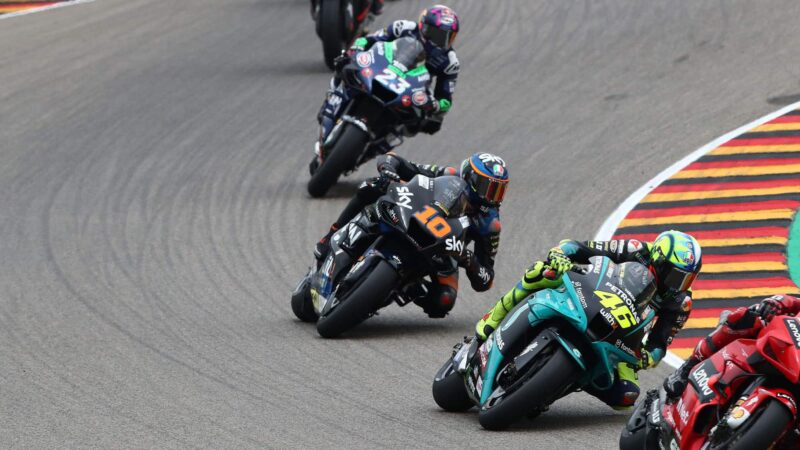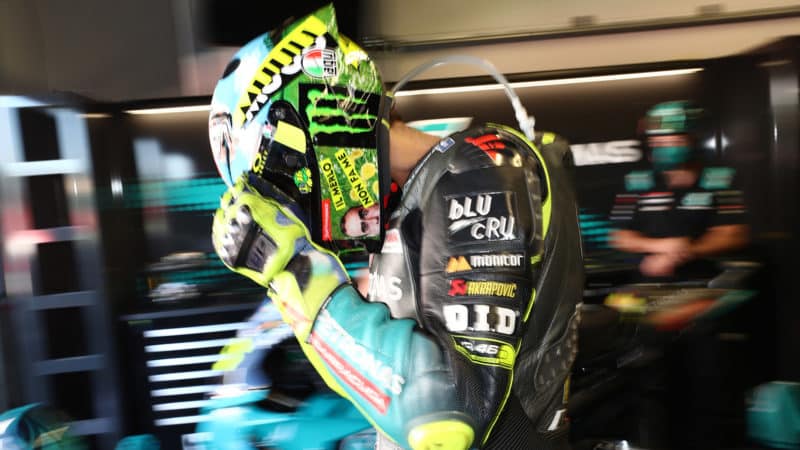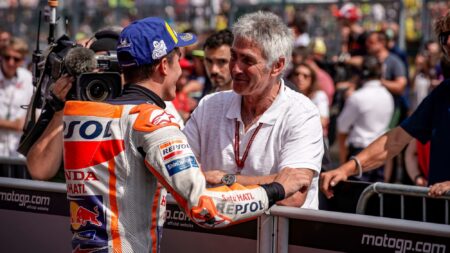That’s why very, very few riders retire when they’re at the top of their game, because life is too good up there.
Twice MotoGP champ Casey Stoner did it, at the end of 2012, and three-times World Superbike champ Troy Bayliss did it in 2008, although not voluntarily. Bayliss had agreed with wife Kim to retire after the 2006 season but kept going for two more years. After that he had to make the decision: stop, or…
Bayliss did quit but spent the next few years gagging to race again.
“I still have heaps of issues about stopping,’ he told me in 2011. “It’s so hard, really hard. If I’d stopped with broken legs or whatever, it would’ve been easy.”
Three years later I interviewed twice World Superbike champion Colin Edwards a few weeks after he had announced his retirement from MotoGP.
“I’m not a believer in retiring at the top,” he told me. “Why the f**k would you want to retire when you’re at the top?! But yeah, year by year it’s been a little bit of a descent.”

Battling with rookies Luca Marini and Enea Bastianini at Sachsenring on Sunday
Petronas SRT
Too right. Edwards didn’t have Rossi’s superstar profile, so he wasn’t able to command factory bikes during the twilight of his MotoGP career. Instead the American rode bargain-basement CRT bikes, powered by dog-slow (relatively speaking) superbike engines, which put him 20th, 14th and 22nd overall in his final three seasons.
Rossi ended last year 15th and currently stands 19th in this year’s championship, with one tenth-place finish, an 11th, 12th, 14th, two 16th places and two crashes from the first eight races.
Last year he scored a podium at Jerez and was in the podium fight at Misano and Barcelona. This year he’s struggling just to get inside the top ten and he’s already crashed as many times as he did in the whole of the 2017 season.
“I was strong, fast and competitive in 2018. From 2019, something changed”
What are the reasons for this?
He’s got older, of course. But there’s more to it than that.
Rossi has won five MotoGP championships with Michelin and two with Bridgestone. However, he’s struggled ever since the introduction of Michelin spec tyres, largely because the carcass of the tyres is softer and more squidgy than the Bridgestones.
Comparing Rossi’s last three seasons with Bridgestone spec rubber with his first three with spec Michelins reveals that his average points score dropped by almost 25%.
And it’s got worse since then, specifically since 2019, when Rossi feels something changed in the rear tyre, which was largely redesigned for 2020, with an even softer carcass.
Of course, in spec-tyre racing it’s the job of the rider and engineer to adapt riding technique and bike set-up to get the most out of whatever tyres they’re given, but Rossi hasn’t been able to adapt because he’s unable to reduce the load he puts into the rear tyre.
“I was strong, fast and competitive in 2018,” he said last weekend. “I wasn’t able to win a race but I arrived P3 in the championship, I made five podiums and I felt strong. After that, from 2019, something changed and from that point we had to set the bike in a very different way compared to the past.

Rossi drives a Ferrari GT3 car in the Gulf 12 Hours race earlier this year
Monster
“All through my career I’ve liked to have a lot of support from the rear tyre and a stiff set-up at the rear, but from 2019 the tyres started to suffer very, very much with this kind of setting, so we need to work with the bike to make the rear a lot softer and ride more smoothly to load the tyre in a better way. Otherwise the tyre gives up.
“But with this kind of tyre and this kind of setting I’m more in trouble and I’m not able to use the benefit of my style. But it’s like this and we need to try to understand the way to improve.”
Remarkably Rossi doesn’t seem to be down in the dumps. He still enjoys riding and the process of looking for answers.



